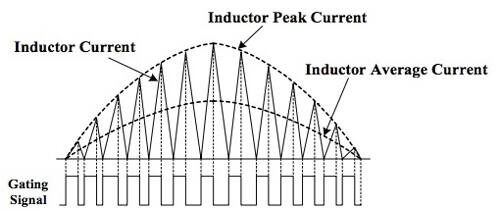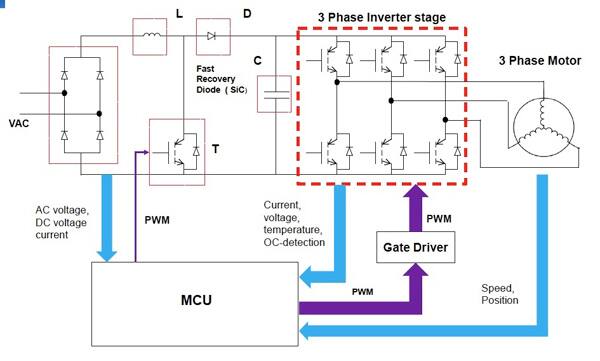Power Factor Correction Maximizes Power Efficiency and Quality in Energy-Harvesting Systems
投稿人:电子产品
2013-12-04
In any power-distribution system, non-resistive loads cause current and voltage to shift out of phase, resulting in energy lost as reactive power. While current and voltage will remain in phase in the case of a purely resistive load, inductive loads store reactive power and cause current to lag the voltage, and capacitive loads cause the current to lead the voltage. When the current waveform does not follow the voltage waveform, not only is power lost, but the resulting harmonics can travel through the power distribution system, disrupting other connected devices.
As the current and voltage waveforms are brought closer together, all the power is contained in the fundamental frequency and harmonics fall to zero. Power Factor Correction (PFC) works to control the current to match the shape and phase of the voltage, maximizing real power available from the source by effectively converting the load to a purely resistive one.
At the micro level, power factor correction offers immediate benefits to designers of energy-harvesting circuits. Power-conditioning circuits used in harvesting energy from ambient sources often result in harmonics in current output, leading to power losses. In these cases, the use of linear regulators results in reduced efficiency when operating outside an optimal operating envelope, while the use of switching regulators can introduce additional design challenges required to address stability issues that can limit optimum power output. PFC circuits are designed to address these challenges.
As a result, power factor correction (PFC) plays a critical role in maximizing real power and maintaining its quality. The simplest way to control the harmonic current is to use a filter that passes current only at line frequency. This filter reduces the harmonic current, which means that the nonlinear device now looks like a linear load. At this point, the power factor can be brought to near unity using capacitors or inductors as required. This filter requires large-value, high-current inductors, which are bulky and can be expensive.
Unlike passive PFC methods, active methods achieve PFC with minimal component count and cost. Drawing on a wide selection of integrated devices, designers can easily implement PFC in energy-harvesting applications using ICs from manufacturers including Cirrus Logic, Freescale Semiconductor, Fremont Micro Devices, Linear Technology, ON Semiconductor, Renesas, STMicroelectronics, Texas Instruments, and Toshiba, among others.
Reducing losses
In a typical power-supply circuit, power factor correction circuitry sits between the rectifier and output storage capacitors (Figure 1). Although power factor can be corrected with passive components, active power correction offers a smaller, more effective solution for many designs.

Traditional PFC circuits can be built to operate in either discontinuous or continuous mode, where the current is either switched on and off during each cycle (discontinuous), or where current never reaches zero (continuous). Critical conduction mode (CRM) is a hybrid, operating between discontinuous and continuous modes. CRM eliminates the dead time that discontinuous mode imposes between cycles until current is switched back on. At the same time, it allows the current to return to zero in contrast to continuous mode. These attributes and its relative simplicity make CRM PFC well suited to low-power applications such as energy harvesting, and designers can choose from a variety of CRM PFC ICs.
For low-power applications, designers can turn to basic CRM PFC devices including the Freescale Semiconductor FAN7527BN, Fremont Micro Devices FT821, ON Semiconductor MC33262, STMicroelectronics L6561, Texas Instruments UCC28051D, and Toshiba TB6819AFG, among others. To implement PFC, these basic devices typically rely on a gating signal to turn a power MOSFET on and off, resulting in a current waveform needed to match the voltage waveform in shape and phase (Figure 2).

Devices in this class typically combine an error amplifier, zero current detector, switch current sensor, input voltage sensor, and switch driver, requiring only a few external components for a complete PFC solution. In addition, these devices typically include built-in circuitry for overvoltage protection, undervoltage lockout, brownout detection, and other faults.
Among differentiators, these offerings boast varying operating current levels and performance characteristics. For their L6561, STMicroelectronics included special circuitry with their linear multiplier to reduce input current distortion to deliver low THD across a wide range of load conditions. For thier FAN7527BN, Fairchild Semiconductor uses a precision two-input multiplier with tight linearity over a wide dynamic range to ensure PFC performance across a range of operating conditions.
Engineers can find CRM PFC ICs designed with special features intended to support efficient power-supply designs. The Linear Technology LT3798 includes circuitry able to sense the output voltage from the primary-side flyback signal, eliminating the need for an optoisolator or signal transformer for feedback.
For their FAN6920MR, Fairchild Semiconductor integrates a quasi-resonant PWM controller designed to reduce input current distortion at zero crossings for improved total harmonic distortion (THD) performance. In addition, this configuration helps reduce switching losses, enabling high-efficiency operation.
Digital control
Digital-based PFC solutions offer a wide range of benefits, including elimination of inaccuracies due to component tolerances and aging. Instead of trimming external components to tune PFC performance, designers can optimize algorithm parameters to achieve desired levels of performance.
The Cirrus Logic CS1501 combines necessary current and voltage-measurement circuitry with a processor core that executes digital algorithms, optimizing MOSFET drive-signal duty cycle and switching frequency to implement PFC. During light-load conditions, the CS1501 can intermittently disable PFC cycles to improve system efficiency.
Designers can also build-in basic PFC functionality with the same integrated MCU used to build the primary application. Designers can implement basic digital-based PFC controllers using integrated MCUs such as the Renesas V850E that include ADC, DAC, and PWM functionality. Here, the MCU eliminates the need for a PFC IC by controlling the gating signal needed to shape input current in a PFC stage for the primary application such as a motor controller (Figure 3).

Conclusions
PFC has emerged as an increasingly important function in energy harvesting, not only to meet regulatory compliance, but also to ensure maximum power efficiency and quality. For many energy-harvesting designs, basic CRM PFC ICs provide the combination of functionality and low-power performance needed to implement power factor correction with minimal additional components and complexity. In some cases, integrated MCUs used to meet application requirements can be leveraged to provide a simple PFC solution.
For more information on the parts discussed in this article, use the links provided to access product information pages on the DigiKey website.
免责声明:各个作者和/或论坛参与者在本网站发表的观点、看法和意见不代表 DigiKey 的观点、看法和意见,也不代表 DigiKey 官方政策。









